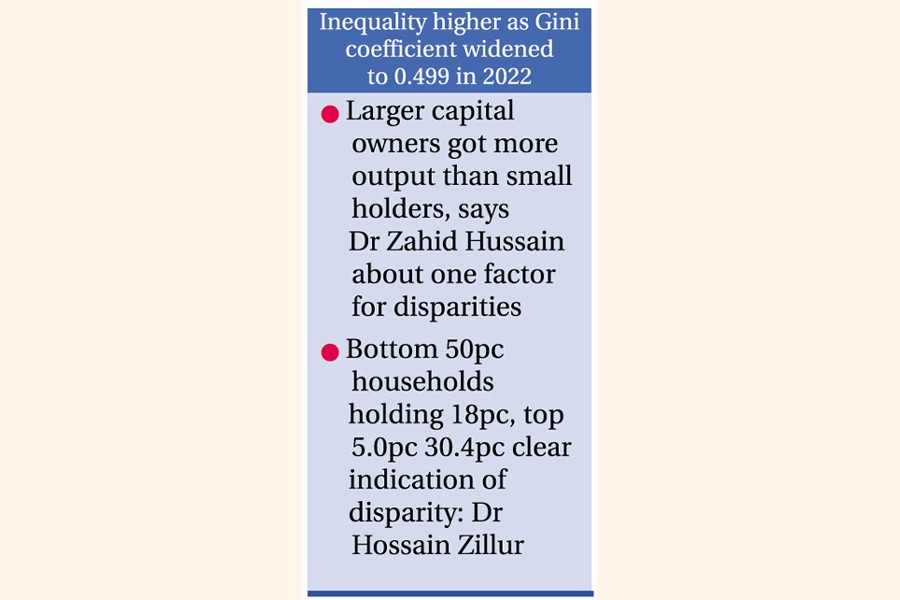
Income inequality, price rises weigh
Mid-income group wobbles under unbearable cost of living
FHM HUMAYAN KABIR | Saturday, 6 January 2024

Middle-income group wobbles under expenditure pressures as their earnings declined compared to their top-and bottom-line peers in income-distribution groups while prices of necessaries kept soaring.
Such hardship of people once having honourable living status in society is obviously delineated in latest government data on households across Bangladesh.
Economists say higher and unequal protections have expanded the income concentration to the top rung (richest group) of the population while that declined in the lower-middle and middle- income groups.
The Household Income and Expenditure Survey (HIES) 2022 by Bangladesh Bureau of Statistics (BBS) has recently shown that the income shares of the top-income group or of the "decile 10" and of the lowest groups including the "decile 1" and the "decile 2" have increased.
On the other hand, the income shares between the declie 3 and decile 9 have dropped, the BBS survey statistics show.
The yawning income differences among the top, bottom and middle-line populations are clearly indicating widening gap between the rich and the poor, economists said.
According to the HIES 2022 report, the share of income of the most bottom-line population or of the "decile 1" increased a little bit to 0.37 per cent in 2022 from 0.23 per cent in 2016.
The share of income of the "decile 2" also widened to 1.31 per cent in 2022 from 1.02 per during the counting period in 2016.
The income share of the top income group or of the "decile 10" also increased to 40.92 per cent in 2022 from 38.09 per cent in 2016, the HIES shows.
However, the income share of "decline 3" declined to 3.88 per cent from 4.05 per cent in 2016, that of "decline 4" fell to 4.82 per cent in 2022 from 5.13 per cent in 2016.
The income share of decile 5 and decile 6 also decreased to 5.81 per cent and 6.92 per cent in 2022 from 6.24 and 7.48 per cent in 2016 respectively.
Similarly, the share of the earnings of the declie 7, declie 8 and of the decile 9 also had fallen to 8.36 per cent, 10.49 per cent and 14.62 per cent in 2022 from 9.06 per cent, 11.25 per cent and 14.86 per cent in 2016 respectively.
Former World Bank Lead Economist at Bangladesh office Dr Zahid Hussain has taken a close look through the data and found an uneven sharing of income within the national economy that is deemed by analysts as factor for the inequalities.
"I have analysed the government's HIES, GDP, Labour Force and other data. I found that the return on capital in Bangladesh for the large owners is higher than the GDP growth."
It indicates that the larger capital owners have got more output than the small capital holders, line shoppers, cottage and small and even medium-scale business or industry holders, he told the FE.
Besides, the income of the Bangladeshi population, mostly represented in the middle-and lower-middle-income groups, from salaries and wages has also declined by nearly 10 per cent, as shown in the HIES 2022 report, he added.
As agricultural income and employment have increased and some people got the facility of the social safety-net programmes a little bit, the income shares of the bottom-line population might have increased a little bit, Dr Hussain said about the income differentials.
"Since government protections, tax incentives and other facilities are ultimately going to the large businesspeople and the lower capital holders are not getting those benefits, the income is being concentrated and the thus income disparity is widening," the senior economist told the FE.
The national statistical body data showed that the Gini coefficient-the gauge for measuring inequality--had widened to 0.499 in 2022 from 0.482 in 2016.
Gini coefficient is the scale from 0 to 1 for measuring the income inequality in a country where "0" indicates no inequality and "1" indicates the highest degree of inequality.
About the higher Gini coefficient, economist Dr Hossain Zillur Rahman said salary and wages of people declined by 10 per cent in 2022 compared to the last HIES survey, which may have a correlation for the growing income inequality.
"The bottom 50-percent Households (HH) hold 18 per cent of the country's total income while the top 5.0 per cent HHs attain 30.4 per cent of the total income, which is a clear indication of the disparity in Bangladesh," he added.